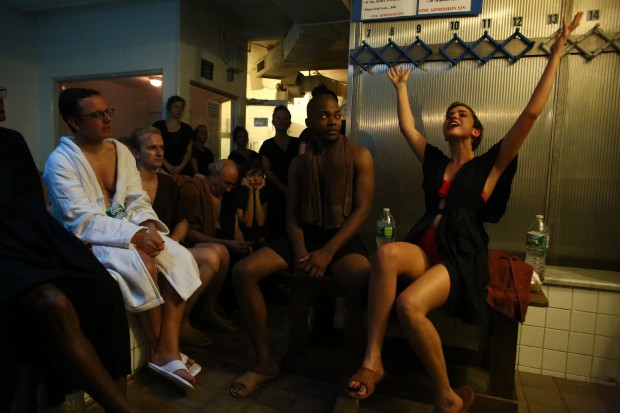Entering a storied East Village bathing establishment around 10 PM one evening, swimsuit in hand as per the instructions, I wondered what exactly I’d gotten myself into. A sense of collective vulnerability permeated the audience as we shed our clothes in the cramped dressing room and slipped on flimsy robes over our bathing suits. We crowded into the hot, but bearable sauna known as the “Turkish room” and exchanged shrugs and “we’re all in this together” glances as we awaited the actors to enter.
Clay, an eager, if somewhat uptight, young black man enters first. He is followed by Lula, a crazed temptress, slightly his senior, who munches on an apple, evoking Eve. Though held in the sauna, the imagined setting is a New York City subway car on a sultry day. The performance is artist Rashid Johnson’s revival of Amiri Baraka’s 1963 Obie-winning play, Dutchman.
The plot of this two-person, one-act performance is simple: Lula sits down next to Clay and goads him into admitting he had been staring at her from a distance. Perceiving his stereotypical attributes, she accurately pins him as an intellectually ambitious middle-class college student from New Jersey en route to a party. Clay is stunned that her suppositions are so accurate, even down to her descriptions of his scrawny friend Warren and her insinuations about his sexual explorations as a child. Flirty banter ensues and tentative plans to attend said party together, and then to have sex emerge, but never materialize. Lula is affronted by Clay’s restraint, despite his obvious yearning for her. Switching tactics, she begins mocking Clay’s diction, his college education, and dapper appearance and, upon failing to get a rouse out of him, she disparages his race and passivity. The dynamics between them quickly devolve into hate-fueled racial politics.
After a brief intermediary scene in the refreshingly cool hallway—a time when one believes there is still a chance for accord between Lula and Clay—the audience then followed the actors into the hottest of all saunas known as the “Russian room,” where the murderous dramatic climax would unfold.
Although most would loathe to admit identifying with either Clay or Lula, the protagonists manage to resonate enough to inspire a degree of pity. Looking around the sauna, it was visible on other audience members’ increasingly squirmy faces.
In a way, we realize both were doomed from the outset. Neither a mild-tempered intellectual black man nor a vixen approaching 30 in a questionable mental state are poised to succeed in our society, especially not in early 1960s when the play was written. Still, between the two of them, Lula proves to yield relative power as she fatally stabs clay. Race, it would seem—more so than gender, education level, or any other social marker—is the trump card.
Johnson’s choice of setting for his revival of Dutchman could have potentially reduced the critically acclaimed drama into a gimmick—but it didn’t. Not everyone could stand the heat. Over the course of several performances, a handful of people got up and walked out for air. Whether they were driven by physical discomfort or emotional anguish or both, is difficult to determine, which is precisely what makes Johnson’s revival a success.



Comments on this entry are closed.